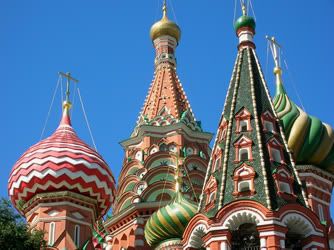
St. Basil's Cathedral, Moscow
I *love* onion domes. They're one of my favorite things about Russia. I think they're incredibly beautiful, and as they're not something you see in the US, I never get tired of photographing them. I have uncountable shots of onion domes, and as I've got three more months to go here in Russia, you know I'm going to collect tons more before I jet on outta here. I've had several people email to ask me questions about these domes I'm forever photographing: What are they for? Do they serve any architectural purpose? Does your house have a dome? Unfortunately, before today I couldn't tell you much other than no, my apartment building does *not* have an onion dome; they're only attached to churches. But as for why, all I could say was that it had something to do with Russian Orthodoxy.
Today, being stuck inside for office hours, with no students coming to meet with me, I was feeling bored out of my mind. This feeling was made even worse by the fact that it's such an incredibly day outside, and that according to weather.com, it isn't going to stay nice for very long. *Must distract self. Must do something on internet.* Aha! I can research the onion dome question. So I did some searching, and here's what I found:
Today, being stuck inside for office hours, with no students coming to meet with me, I was feeling bored out of my mind. This feeling was made even worse by the fact that it's such an incredibly day outside, and that according to weather.com, it isn't going to stay nice for very long. *Must distract self. Must do something on internet.* Aha! I can research the onion dome question. So I did some searching, and here's what I found:
On the roof of Orthodox churches are usually found one or more cupolas (towers with rounded or pointed roofs), called crests or summits. One cupola signifies Christ, the sole head of the Christian community; three cupolas symbolize the Most-Holy Trinity; five cupolas represent Christ and the four Evangelists; seven cupolas symbolize the Seven Ecumenical Councils which formulated the basic dogmas of the Orthodox Church, as well as the general use in the Church of the sacred number "seven"; nine cupolas represent the traditional nine ranks of Angels; and thirteen cupolas signify Christ and the Twelve Apostles.
A peculiar feature of Russian Orthodox churches is the presence of onion-shaped domes on top of the cupolas. In the early history of the Russian Church, especially in Kiev, the first capital, the domes of the churches followed the typical Byzantine rounded style, but later, especially after the Mongol Period, Russian churches tended toward the onion domes, which, in many places, became quite stylized. Historians are not in agreement as to the origin of this particular style, but some point to the possible influence of Persia on this peculiar feature of Russian church architecture, while others argue that since this style was more popular in the far North of Russia, it had a practical application, in that the shape was particularly suited to shed the large amounts of snow common in the region.

4 comments:
In Yaroslavl, several of the churches there have other mystical numbers of domes - I seem to remember that Ioann the Predtechy church has something like 15 domes for some spiritual/mystical reason.
I actually had done the same thing that you discuss here and read about the domes and their colors and meanings. Green, blue and gold colors represent the holy trinity, spirity of God, and Jesus. Green is for monasteries typically.
If you are into these church domes, Yaroslavl is a great destination. Rostov Veliky is quite cool and ancient also - I stayed several nights in the hotel in the kremlin there ("Дом на погребах") and made some night photos of the white walls, churches and domes. It just felt ancient and a bit spooky, to be honest.
Onion Domes..you can see these also in bavarian,germany.
greetings ...michael
cool info on the cupolas! I miss the church bells in oh heavens whats the name of that little town/tourist haven near vladimir?
w. shedd - i really do want to go to both yaroslavl and rostov veliky.... don't know if i'll have time though :-(
adeline - SUZDAL!!!
Post a Comment